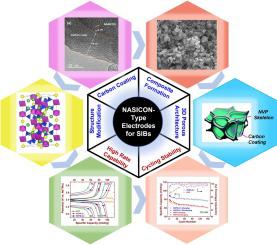Progress in Materials Science ( IF 33.6 ) Pub Date : 2023-04-14 , DOI: 10.1016/j.pmatsci.2023.101128 Raghunayakula Thirupathi , Vandana Kumari , Sumanta Chakrabarty , Shobit Omar

|
Sodium-ion batteries (SIBs) have emerged as the most promising energy storage devices for large-scale grid and electric vehicle applications. This is because of the natural abundance, high availability, and cheap resources of Na. Since the electrochemical performance of the battery is heavily dependent on the capacity, storage reversibility and structural stability of the cathode, various materials have been explored for SIB cathode. Among them, NASICON-framework oxides have shown immense potential owing to the 3D open-framework structure, which remains stable upon the extraction/insertion of large sodium ions. Besides, the [PO4]3- units introduce a strong inductive effect, resulting in higher redox potential compared to other layered oxides. Nevertheless, the poor electronic and ionic conductivities are the major drawbacks of these materials. Various compositions are reported, and several advanced processing methods are employed to overcome these challenges. This review discusses the experimental and theoretical studies performed to establish the storage mechanism and sodium diffusion pathways inside the NASICON-structured oxides. Particular emphasis has been given to the multiple strategies used to understand the correlations between the structure, chemistry, processing, and underlying mechanism in these electrodes, which eventually affect the energy density and cycling performance of batteries. Moreover, this article also reviews the work done in evaluating the performance of full sodium-ion battery cells utilizing NASICON-structured cathode and other materials as an anode.
中文翻译:

钠离子电池NASICON骨架电极的最新进展与展望
钠离子电池 (SIB) 已成为大规模电网和电动汽车应用中最有前途的储能设备。这是因为钠的天然丰富性、高可用性和廉价资源。由于电池的电化学性能在很大程度上取决于正极的容量、存储可逆性和结构稳定性,因此已经探索了各种材料用于 SIB 正极。其中,由于 3D 开放式框架结构,NASICON 框架氧化物显示出巨大的潜力,在大钠离子的提取/插入时保持稳定。此外,[PO 4 ] 3-单位引入了强烈的感应效应,导致与其他层状氧化物相比更高的氧化还原电位。然而,较差的电子和离子电导率是这些材料的主要缺点。报道了各种成分,并采用了几种先进的加工方法来克服这些挑战。本综述讨论了为建立 NASICON 结构氧化物内部的存储机制和钠扩散途径而进行的实验和理论研究。特别强调了用于理解这些电极的结构、化学、加工和潜在机制之间的相互关系的多种策略,这些策略最终会影响电池的能量密度和循环性能。而且,











































 京公网安备 11010802027423号
京公网安备 11010802027423号